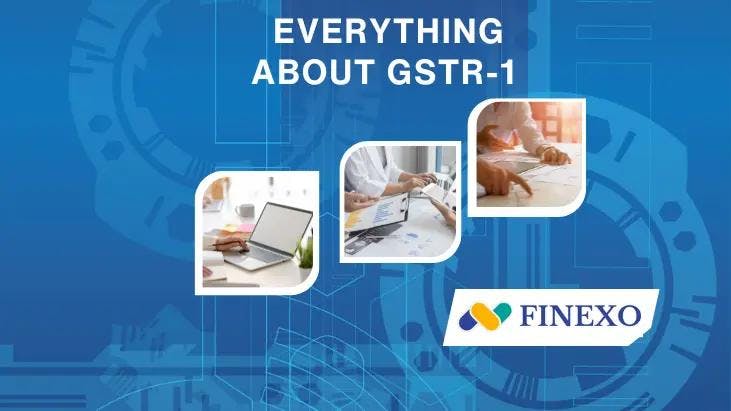
GSTR-1 - Everything you need to know
Introduction
Every regular taxpayer needs to file a GSTR-1 return on a monthly or quarterly basis.
GSTR-1 includes details related to sales, credit notes and debit notes. No information regarding purchases is there in GSTR-1.
Who are required to File GSTR-1?
Every registered person, including a casual taxable person is required to furnish details of outward supplies (like sales, transfer of goods or services or both) for the month (aggregate turnover more than 5 crores) or quarter (turnover up to 5 crores) in form GSTR –1.
However, following categories of taxpayers are not required to file GSTR-1-
- Input service distributor
- Non-resident taxable person
- Composition taxpayer
- Person deducting tax at source
- Person collecting tax at source
- Supplier of OIDAR services located in non-taxable territory providing services to non-taxable online recipient
A nil GSTR-1 can be filed through an SMS using a registered mobile number.
Filing Frequency
A person whose turnover is more than Rs. 5 crore in the preceding year is required to file monthly GSTR-1 and GSTR-3B. Other persons can opt for quarterly filing under QRMP scheme (Quarterly return and monthly payment). A person who has opted for quarterly filing has to file GSTR-1 on quarterly basis.
Due Date
Time limit for filing GSTR- 1 is as follows -
| Category | Time Limit |
|---|---|
| Person opting QRMP scheme | Till 13th of next month from quarter ending |
| Others (regular scheme) | Till 11th of the next month |
A taxpayer cannot file GSTR-1 before the end of the current tax period. (before end of quarter/month)
However, following are the exceptions -
- If a casual taxable person has closed his business
- Cancellation of GSTIN of a normal taxpayer
In cases where taxpayer converted from normal taxpayer to composition taxpayer at the beginning of any financial year then GSTR –1 will be available for a period for which he was a normal taxpayer.
Maximum time limit for furnishing form GSTR-1
The maximum time limit up to which a registered person can furnish the details of outward supplies in in form GSTR-1 for a tax period is 3 years from the due date of furnishing such details. However, this time limit can be extended by the government subject to some conditions and restrictions.
In what cases a registered person is not eligible to furnish details of outward supplies in GSTR-1-
- A registered person is not allowed to furnish details of outward supplies if he has not furnished return in GSTR 3B for the preceding two months. (under normal scheme)
- A registered person opting for QRMP scheme shall not be allowed to furnish details of outward supplies in form GSTR-1 or filing IFF, if he has not furnished GSTR 3B for the preceding tax period.
- A registered person who is restricted from using the amount available in electronic credit ledger to discharge his liability towards tax in excess of 99% of such tax liability under rule 86B of CGST rule, shall not be allowed to furnish details of outward supplies in form GSTR-1 or using IFF, if he has not furnished GSTR-3B.
Contents of GSTR-1
Basic details-
- GSTIN
- Legal name and trade name of business
- Year and month
- Aggregate turnover in previous year
- HSN wise summary of outward supplies
- Details of documents issued during tax period
Details of outward supply-
- B2B including UIN holders
- B2C interstate supplies where invoice value exceeds 2.5 lakhs
- Other B2C supply details (consolidated detail)
- Zero-rated supply
- Deemed export
- Debit/credit notes issued
- Nil rated/exempted/non-GST
- Advance received/adjusted
- Amendments for the prior period
- HSN/SAC wise details
- Documents issued details
To summarise we can say that for B2B supplies, all invoices need to be uploaded in GSTR-1 irrespective of whether they are inter or intra-state. Because in the case of B2B supplies (where recipient is registered) recipient avails benefit of ITC. For B2C supplies invoice-wise details are not required but if the value of the invoice is more than 2.5 lakhs in inter-state supply then supplies need to be uploaded. For all other invoices state wise summary and consolidated details need to be given.
How to submit invoice related details
Scanned copies of invoices are not required to be uploaded. Only relevant fields are required to be furnished like invoice number, value and date etc. A description of each item is not needed, only HSN code in respect of supply of goods and accounting code in respect of supply of services is needed. Taxpayer is required to report HSN as under-
| Aggregate annual Turnover | HSN digits |
|---|---|
| Up to 5 crores | B2B supply- 4 B2C supply- 4 (optional) |
| More than 5 crores | 6 |
Amendments in GSTR-1
GSTR-1 has an amendment table where supplier can give details of original invoices which have been wrongly entered in GSTR-1 of the earlier months and now required to be amended. Tables 9, 10 and 11(II) provide facility for amendments. Suppliers can rectify any error or omission in the tax period when it is noticed and pay tax and interest in case of any short payment.
Time limit for rectification of errors
If for some reasons, supplier could not make correction at the time of filing of GSTR-1 when he noticed mistakes, then maximum time limits within which such amendments are permissible is earlier of the following dates-
- 30th day of November of next financial year to which such details pertain or
- Date of filing of relevant annual return
Nil GSTR-1
Filing of GSTR-1 is mandatory for all taxpayers even if there is no business activity in any tax period.
For such a period Nil GSTR-1 is required to be filed. A nil GSTR –1 does not have any entry. A nil GSTR–1 can be filed through an SMS using the registered mobile number of the taxpayer.
Late fees
The late fee to be charged in case of late filing of GSTR-1 is Rs. 25 for delay of every single day in CGST act and the same fees is applicable in SGST act. It means that a total of Rs. 50 is to be paid for delay of a single day. Maximum late fee is 5000 rupees as per CGST act 2017. However if turnover is up to 1.5 crores, then the maximum late fee is Rs. 1000 and for turnover is 1.5 crores to 5 crores then the maximum late fee is Rs. 2500 rupees.
As per CGST act, for nil GSTR late fee is 10 rupees for every day of delay and maximum late fee is 250 rupees.
Recent amendments
New tables 14 and 15 have been introduced in GSTR-1 from January 2024. Table 14 is inserted for details of supplies made to e- commerce operators under section 9(5) where ECO is liable to pay tax and for section 52 (TCS). Table 15 has been added for supplies made under section 9(5) of the act.
Important sections/notifications/rules
| Section | Topic |
|---|---|
| Section 37 of CGST act | GSTR-1 |
| Section 2(83) of CGST act | Definition of outward supply |
| Section 47 of CGST act | Late fee related to GSTR-1 |
| Rule 67A | Nil return |
| Notification No. 78/2020 dated 15.10.2020 | Requirement of HSN |
| Notification 83/2020 CT dated 10.11.2020 | Time limit for furnishing GSTR-1 |
About CA Shravagi Jain
CA Shravagi Jain has completed her CA in 2021. She is engaged in writing articles and also teaching CA students.
